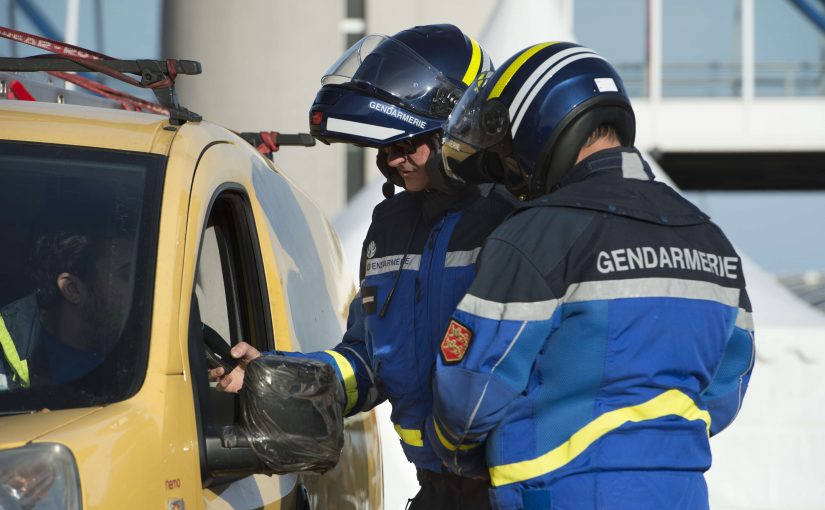France has a population of 65.9 million inhabitants, living in very different populated areas: more than 10 million are living in highly dense urban areas, whereas many others are living in very rural areas where travel by road is a critical part of their daily life. In an area slightly smaller than Texas (268,596 sq. mi.), France (248,573 sq. mi.) counts around 1.1 million kilometers (around 685,000 miles) of road network; more than 1 million kilometers encompass the secondary road network outside highways and the national road network. Around 58 percent of France’s road fatalities in 2023 occurred on this secondary road network1.
On highways, the speed limit for light vehicles is set at 80 mph (130 km/h), reduced to 68 mph (110 km/h) in case of rain. On major national roads with two lanes for each direction and a physical separation (median) between the two directions, the maximal speed is set at 68 mph (110 km/h). Outside urban areas, on roads with one lane for each direction, the general speed limit is set at 50 mph (80 km/h) with local exceptions for 56 mph (90 km/h). In urban areas, the speed limit is set at 31 mph (50 km/h), and cities have the possibility to set the speed limit at 18 mph (30 km/h), as is the case for densely used narrow streets in the center of Paris, for example.
Around 48 million vehicles are registered in France—38 million cars, 6.2 million utility vehicles, 3 million motorcycles, and 700,000 trucks. In addition to the traffic of these vehicles, France has to address important commercial transit between northern and southern Europe, as well as an important transit for tourism, especially in the summer.
Public Policy for Road Safety in France Before 2023
The long-term improvement in road safety in France is the result of a combined proactive action in design, maintenance, and operation of infrastructure; passive and active safety of vehicles; the education, prevention, and enforcement of road user behavior; and post-crash care improvement.
After the World War II, the expansion of the car fleet, the inadequate road network, and insufficient training of drivers led to a massive increase in road crashes. The crash data collection system, which was made reliable in 1954, recorded more than 7,000 road fatalities. Between 1960 and 1970, road fatalities increased by 56 percent as traffic more than doubled. However, during this period, road fatalities per million kilometers traveled decreased from 111 to 811.
Between 1970 and 1980, the interministerial road safety committee was created with the appointment of an interministerial delegate (see sidebar). In 1972, the peak of 18,000 road fatalities was reached. In 1973, the 16,000 inhabitants of the French Mazamet city decided to launch a collective awareness action by laying down on the street. This event was shown on TV and in different newspapers, thereby helping the government to impose mandatory use of safety belts for front occupants and helmets for all motorcyclists. During this period, the road fatalities decreased by 30 percent while the traffic increased by 1.6 times.
Between 1980 and 1990, the blood alcohol limit was lowered from 0.12 percent (1.2 g/L) blood alcohol concentration (BAC) to 0.08 percent (0.8g/L), and the local road safety policy was implemented with district plans. The construction of roundabouts to replace hot spot crossroads significantly reduced the road fatalities, as did the mandatory regular vehicle technical assessment introduced in 1985. Mandatory use of child restraint systems and the immediate withdrawal of drivers’ licenses in cases of drunk driving were introduced in 1986. The number of road fatalities decreased by 20 percent, while the traffic increased by 140 percent.
A white paper on road safety issued in France in 1989 proposed different improvements for public policy and outlined the need to improve enforcement. Therefore, between 1990 and 2000, the speed limit in urban areas was set to 50 km/h (30 mph), and the BAC limit was reduced to 0.05 percent. During this period, the penalty point–based driver’s license was also introduced. Most of the motorway network was completed, and vehicles were progressively equipped with airbags. In addition, the use of seat belts for all vehicle occupants was made mandatory. Last, a continuous training in road safety was introduced throughout the school curriculum. The road fatalities decreased by 20 percent even though traffic increased by 20 percent.
At the beginning of Jacques Chirac’s second term as president of the French Republic in 2002, he listed road safety among his four priorities. Enforcement was significantly improved with the progressive development of fixed automated speed cameras. For novice drivers, a probationary driver’s license with six points was introduced in 2004, and the consequence for exceeding the legal BAC limit was increased to six penalty points for all drivers. With less than 5,000 road fatalities in 2006, and a 51 percent reduction in road fatalities during the decade, more than 30,000 lives were saved during this period.
Since 2010, road safety remains one of the major public policies in France, which took up the United Nations goal of the first decade of action (2010–2020) to halve the road fatalities during this period, aiming to be below 2,000 fatalities in 2020. However, the road fatalities increased between 2014 and 2015 and were stable in 2016 and 2017. With the acceleration of the aging of the population since 2010, the share of senior drivers in the road fatalities is constantly increasing, while the excess risk for 18–24 years old is decreasing more than that of other adults.
Road Safety Challenges for 2023–2030
The most important decisions on road safety are discussed in the National Council for Road Safety, which brings together all the main stakeholders in road safety: representatives from different ministries, from major industry associations (transport, education, cabs, etc.), road users (cyclists, car and motorcycle drivers, pedestrians), academics, and physicians. The decisions are also prepared in the Higher Council for Road Education, which brings together representatives from different ministries as well as from the major road education industry (driving schools) and road users to discuss new perspectives for road education.
Every three to five years, this work is then proposed by the delegation for road safety for approval by the Interministerial Committee on Road Safety, chaired by the prime minister and bringing together the different ministers (justice, health, education, transport, interior). In order to take advantage of the switch of some mobility modes originating from the COVID-19 period, the last Interministerial Committee on Road Safety meeting was held on July 17, 2023, and approved 38 measures organized in seven priorities:
-
- Improving education about shared road use: Introduce a cycling module in secondary schooling, make the driving license process less expensive, and provide the opportunity for lifelong learning on road transport.
- Enhancing the detection, assessment, and monitoring of unfit drivers: Enhance the detection of hazardous behavior and improve the process of driver medical assessment.
- Protecting vulnerable road users and helping victims: Improve the network of major facilities, implement consultation for cargo bikes, impose an 18 mph (30 km/h) speed limit on urban roads without footpaths, and conduct research on ways to protect roadside workers.
- Working to ensure safety of all road users: Educate users on the correct use of edge lane roads, support actions of associations at the local level, and encourage the promotion of occupational road safety.
- Combating the most hazardous behaviors: Reinforce the penalties for driving under the influence, reinforce targeted mandatory use of breath alcohol ignition interlock devices, criminalize excessive speeding, criminalize driver misidentification by the vehicle owner when an offense is committed.
- Simplifying life for road users: Untangle the digital process for vehicle registration, simplify the digital consultation of the driver’s license number of points by the driver, and introduce mobile driver’s licenses and digital vehicle insurance stickers.
- Taking action to improve road safety in overseas territories and regions: Adapt communication to local communities and challenges, create new local partnerships, enhance enforcement, and improve post-crash care.
For the first time in many years, France counted 3,167 road fatalities in 2023, which is 4.3 percent lower than the road fatalities of 2022. The figure from 2023 corresponds to 48 road fatalities per million inhabitants, which is the best rate since 2010 without taking into account the pandemic-impacted years of 2020 and 2021. France had the 16th best road safety performance in Europe in 2023. Since 2010, road fatalities in France have dropped by 20.5 percent; however, road injuries were reduced only by 17 percent1.
In 2023, 59 percent of road fatalities occurred on rural roads and individuals in the 14–18 and 24–34 age groups have a higher fatality rate than other road users. About 48 percent of road fatalities are car occupants, 22 percent are motorbike drivers (less than 2 percent of road traffic in France), 14 percent are pedestrians, and 7 percent are cyclists. The main factors contributing to road fatalities in 2023 were speeding (28 percent of fatalities), distraction (12 percent), and drug use or having a fainting spell (11 percent). Despite the 7.5 million alcohol and drug tests done by law enforcement in 2023, alcohol was a main factor for 22 percent of road fatalities. In a nutshell, 40 percent of all road fatalities in 2023 occurred with at least one driver either drunk, under influence of narcotics, or both.
Conclusion
Implementing an efficient road safety policy takes time and requires strong political support, and France is honored to share its experience with partners from all over the world and to take part in the management of the United Nations Road Safety Fund. However, the development of road safety policy in France shows that the next challenges are mainly related to the users’ behavior (e.g., use of mobile phones, transgressive behavior, aggressiveness); the use of new drug forms potentially impairing driving (e.g., edibles); and the technical evolution of transport modes (e.g., automated and autonomous driving, driver assistance systems). In order to facilitate this huge amount of work, the French road safety delegation is closely involved in the international works of the European Union and of the United Nations Global Forum for Road Traffic Safety. At an informal working level, the delegation for road safety is also involved in the work of the road safety committee established within Francopol.
A lot of work is still to be done, and the United Nations ministerial meeting in 2025 in Morocco has clearly shed a new light on world leaders’ common commitment to continuously and quickly improve road safety for all users. d
Note:
1 Observatoire National Interministériel de la Sécurité Routière. “Bilan de la Sécurité Routière 2023.” September 12, 2024. https://www.onisr.securite-routiere.gouv.fr/sites/default/files/2024-09/Bilan%20SR%202023%20version%20site%20internet%2012%20septembre.pdf.
Please cite as
Florence GUILLAUME, “France’s Step-by-Step Road Safety Policy,” Police Chief Online, March 26, 2025.



